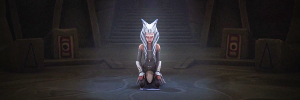Hello everyone,
I recently thought of a potential problem with the Narnia stories that I think the Netflix series should seek to clarify, and I'm not sure if anyone else has pointed this out or not, so here goes.
In Narnia, we have Talking Beasts and Dumb Beasts. It is unlawful to kill a Talking Beast in cold blood, as with a human, yet it is permissible to kill a Dumb Beast for food or some other useful purpose.
Now what about trees? The trees (or Dryads, or Hamadryads or Silvans) seem to be entirely exempt from commercial use, and are even called "holy" in the Last Battle. All the trees in Narnia seem to come to life in Prince Caspian when Aslan calls them, implying that they are all live beings with souls and minds.
Now this begs the question: where do Narnians get their lumber? Do they simply use trees from other countries (which might be "Dumb" trees) or do they have to borrow dead wood or fragments from Narnian trees? If so, how could any sturdy timber structures (or even the good ship Dawn Treader) be constructed with rotten or dead wood fragments that the trees themselves don't want?
I think this should be explained through some amount of dialogue in the new series.
So... what are your thoughts? Do you think it's not a big deal? (Narnia is a "magical" world after all.) If you do think it matters, how would you explain this problem?
PM me to join the Search for the Seven Swords!
Co-founder of the newly restored Edmund Club!
Did I mention I have a YouTube Channel?: https://m.youtube.com/channel/UCeuUaOTFts5BQV3c-CPlo_g
Check out my site: https://madpoetscave.weebly.com
signature by aileth
I'm rereading The Last Battle at the moment and a couple parts stuck out at me in relation to your question, Cleander...
One, when Jill shoots a rabbit for food while camping out at the tower, the narrator says that there are lots of dumb rabbits in Western Narnia. Second, the Talking Rat that they meet on the river sailing a raft of trees seems like he's an old hand at this sort of thing. Those two things lead me to believe that as one moves west of Narnia, into the Western Wild, you encounter fewer and fewer talking beasts and trees, and that Narnians probably got their lumber (and game) there and sailed it down the river into the Narnian kingdom.
They could just try to ignore the question altogether in an adaptation, but if it's an expansive series, they will probably try to address it in some way so that the world-building feels more complete. (I will say that it rather bothers me that the first person that Jill and Eustace meet in Narnia is a Talking Bird, and then they spend a good part of their quest shooting birds out of the sky for dinner...  )
)

That's a good point about the Western Woods being more "wild"! It seems possible to me that may be what Lewis was originally thinking;
Your last observation (about the Talking Birds) reminds me of the way that a similar issue was handled in Prince Caspian- the issue of the Dumb/Talking Bear. The movie (and I guess the book too  ) made a clear contrast between the wild and talking bears- you see the need to kill one as a dangerous monster, and the importance of the other (meaning the bear who turns up later in Caspian's army) as a functional, intelligent member of society. (Well, maybe I could have left out that "intelligent" part...)
) made a clear contrast between the wild and talking bears- you see the need to kill one as a dangerous monster, and the importance of the other (meaning the bear who turns up later in Caspian's army) as a functional, intelligent member of society. (Well, maybe I could have left out that "intelligent" part...)
This idea kind of opens up a new (or maybe old) discussion on how Netflix should adapt these books: that is, they need to take time in the dialogue to build the world (To borrow your phrase.). It shouldn't be 99% plot exposition, with the remaining 1% comprising any humor and character development in the films. I'm hoping for much slower paced, realistic conversations in the script that will allow characters to discuss things like this.
PM me to join the Search for the Seven Swords!
Co-founder of the newly restored Edmund Club!
Did I mention I have a YouTube Channel?: https://m.youtube.com/channel/UCeuUaOTFts5BQV3c-CPlo_g
Check out my site: https://madpoetscave.weebly.com
signature by aileth
In fairytales with sentient trees, sometimes people ask them for the wood to build things. Typically that means using the right sort of respectful words or perhaps a ritual. And then people are able to either cut branches off or the tree itself donates. Actually, this is hinted at in PC: after the battle and the romp, the dryads break off bits of themselves to make the bonfire.
That could make a nice scene in VDT. At the start Caspian is preparing to fulfill his vow and requests wood to build the Dawn Treader from the dryads.
Those two things lead me to believe that as one moves west of Narnia, into the Western Wild, you encounter fewer and fewer talking beasts and trees, and that Narnians probably got their lumber (and game) there and sailed it down the river into the Narnian kingdom.
I finished up LB last night and I should amend my previous thoughts: dumb trees may be more plentiful in Western Narnia, but I don't think many people besides Digory and Polly ever ventured into the Western Wild. It seems that the cliffs that formed the Great Waterfall barred exploration into those parts. (Can't help but think of the way cliffs are used in video games to keep players from going beyond certain areas.  )
)
That could make a nice scene in VDT. At the start Caspian is preparing to fulfill his vow and requests wood to build the Dawn Treader from the dryads.
Oh, I really like that idea! I would think that a ship built from dryad's wood, freely-given, would be especially seaworthy. And excellent point about the dryads building the bonfire in PC. Since Narnia isn't industrialized, nor do they use large medieval weapons of war (it's the Calormenes that use a battering ram, for instance), I would think that dumb Western wood and the gifts of dryads would be enough to suffice its need for lumber.
On a related note, I was researching The Lefay Fragment earlier, trying to jog my memory about the part where Digory saws off a branch of the Oak and loses his ability to speak to trees and animals in the process, and I ran across this book: Narnia and the Fields of Arbol: The Environmental Vision of C. S. Lewis. Looks like it could be a useful read for this topic. (I really hope that the Netflix folks will read Lewis scholars!)

Personally, my interpretation of the mention of the prevention of cutting down "good trees" and references to "the holy trees" were references to specific trees. I assumed that, much like the Talking vs. Dumb beasts, there were Living vs. dead (metaphorically, of course) trees, and the good Kings and Queens of Narnia had some means of telling the difference. In hindsight, though, I realize this was my assumption; I don't think the books really say one way or the other.
I do love Rosie and Dot's suggestions, though - both feel very Narnian to me. In a world where the trees talk, it makes sense to me that if you need lumber, the best way to get it is to ask the trees' permission. This also ties into when the trees fall silent when the Telmarines control Narnia - the Telmarines likely made no effort to respect the trees' wishes and seem to have cut down any tree they wanted, so there was no point in the dryads trying to maintain communication.
Similarly, the idea that certain places are more or less magical - or more or less wild - feels very Narnian as well. You get a certain sense that Narnia is more magical than the rest of the world - even Archenland doesn't have talking animals in the same numbers that they do in Narnia - so getting wood from dead/dumb trees just outside the more magical sites makes a lot of sense.
N-Web sis of stardf, _Rillian_, & jerenda
Proud to be Sirya the Madcap Siren

